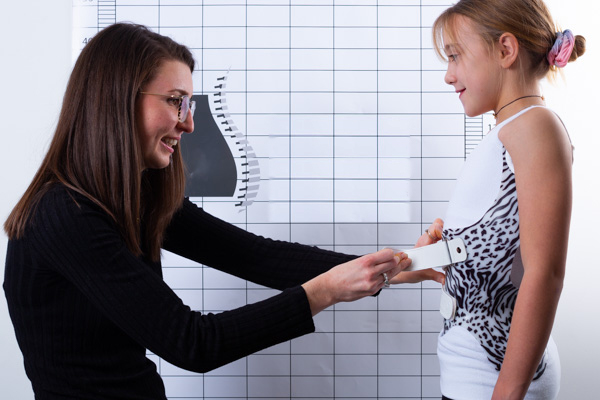Katharina Schroth was born in 1894 in Dresden, Germany, and by the age of 16 was suffering from moderate scoliosis. After undergoing treatment with a steel brace and finding it heavy and cumbersome, she began to develop her own more functional approach, with corrective breathing and over corrective positioning in front of a mirror.
By 1921, Schroth’s new method of treatment involving specific postural correction, corrective breathing patterns and postural perception, was being carried out along with rehabilitation exercises in her own clinic.
She and her daughter Christa Lehnert-Schroth opened an institute in Bad Sobernheim in West Germany which eventually expanded with a capacity to treat 150 inpatients at a time. The institute became the Asklepios Katharina Schroth Klinik in the 1980s. By the end of the 1930s, Schroth treatment had become widely accepted in Germany as the best form of conservative treatment to treat curvature of the spine.

Dr. Jacques Chêneau was a French orthopaedic surgeon who made significant contributions to the field of scoliosis treatment. Dr. Chêneau's work focused on achieving in-brace correction, aiming not only for stabilisation but also improvement in the alignment of the spine.
Since its initial development, Chêneau bracing has been intertwined with the Schroth concept for scoliosis.
Dr Chêneau visited Katherina Schroth and Christa Lehnert-Schroth at their renowned clinic in Germany. He immediately understood the efficacy of the Schroth breathing concept and incorporated this into his brace designs using the augmented Lehnert-Schroth curve-pattern classifications, which for decades have been the basis of Schroth scoliosis treatment.
In 1979, he developed the Chêneau brace. Chêneau brace design acknowledged that scoliosis is a three-dimensional condition and focuses on the correction of the spine in the coronal (front), transverse (rotational) and sagittal (side) planes.
The Chêneau brace is recognised for its asymmetry and unique design, allowing for Schroth corrective breathing while the patient wears it. In its design, it uses pressure zones and expansion areas to move the spine into a more normal position.
You can see more research papers and publications on Schroth and support for the Chêneau-Gensingen brace on our scoliosis clinical research page.
Scoliosis is a condition where there is an abnormal curvature of the spine. It is a three-dimensional condition with deviation of the vertebrae in the sagittal, coronal and transverse planes.
There are visual clues that a parent should be aware of:
See our visual signs and symptoms of scoliosis post for more information.
The LOC Scoliosis Brace is a 3D, hypercorrective, Cheneau-Gensingen derivative brace, known as one of the most corrective and modern scoliosis braces available in the UK. It is designed to:
The brace is entirely unique and tailored to the patient’s spinal curve pattern, ensuring optimal skeletal correction while prioritising comfort.
Unlike traditional braces, it opens from the front for easier self-application and maintains a low profile under clothing.
The LOC Scoliosis Brace is worn 22 hours a day (including nighttime) and works in conjunction with Schroth-based therapy for maximum results.
The operation used to treat severe scoliosis curves is typically spinal fusion surgery; a major procedure that involves moving muscles and realigning the skeleton into place. The curved, deformed vertebrae are fused together into a single bone, putting metal screws and rods into the spine to help straighten it. Surgery typically lasts between 4 and 8 hours depending on the severity of the curve. Bone graft is then taken from other parts of the body and used to cover the implants.
The London Orthotic Consultancy launched its own Cheneau-Gensingen derivative scoliosis brace in January 2022, the LOC Scoliosis Brace.
Our brace is based on well-established Schroth-based principles and research. Our brace has been fine-tuned according to feedback from our scoliosis patients and from referring spinal consultants.
This is to ensure we are achieving as much skeletal correction as possible in-brace for each individual user, whilst also making our brace as comfortable as possible.

“It’s life-changing, my swimming coach has even remarked what a difference my treatment has made" Read how pectus bracing treatment helped to correct Aris' complex chest deformity, involving a combination of pectus excavatum, pectus carinatum and rib flaring.

Cerebral palsy patient Lucas sees significant improvement in his walking after only six months in his new custom Ankle Foot Orthoses (AFOs), designed by Professor Saeed Forghany in our Manchester clinic. Hear how a detailed gait analysis and bespoke AFOs significantly improved Lucas's gait and comfort.

Freddie’s positional plagiocephaly was treated successfully with the LOCBand Lite, going from 11mm to 2mm after four months in his helmet.

Adult club foot (talipes) patient Natasha says, "I cannot stress how amazing my AFOs are and how they have changed so much for me. The support they give me allows me to walk without crutches outside the house for the first time in over fifteen years."

Diagnosed with adolescent idiopathic scoliosis at 14 years old, Polly and mum Zoe looked to the LOC Scoliosis Brace to help her curve and avoid surgery at a later date.

LOC opens its first clinic in Northern Ireland, LOC Belfast, offer non-surgical orthotic treatment for scoliosis, pectus carinatum and pectus excavatum. Here, we will also be able to provide orthotic treatments for a range of adult and paediatric lower limb conditions including cerebral palsy, spina bifida, hypermobility, stroke, post-polio syndrome, and multiple sclerosis.

Mum Natalie shares her experience of having both her identical twins diagnosed with craniosynostosis. Ella and Nina had surgery at Great Ormond Street Hospital before going through cranial remoulding therapy at the London Orthotic Consultancy.

See how a thorough gait analysis and a correctly-fitted, bespoke Reciprocating Gait Orthosis (RGO) helped Ted, a spinal surgery and cancer survivor, improve his rehabilitation and mobility goals, getting him back on his feet again.